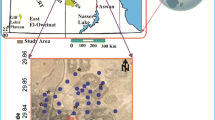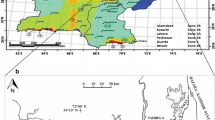Abstract
Trabzon province located on the shore of the Black Sea in the NE Turkey approximately 150 km distance from the North Anatolian Fault (NAF) which is the most dangerous fault system in Turkey. In addition, the 1939 Erzincan earthquake with Ms = 7.9 occurred, which caused many loss of life and property nearest to the study area on the NAF system, and after this earthquake, many more destructive earthquakes occurred on the NAF system. Determining the soil characteristics of the KTU campus in Trabzon is important in terms of reducing earthquake damages. Therefore, ambient noise recordings were carried out at 75 single-points and 2 reference points and in the five faculty buildings located in this area. The analysis of ambient noise record provided the identification of the local site-effect of KTU campus with horizontal to vertical spectral ratio (HVSR) and standard spectral ratio (SSR) methods and site-structure resonance effect of faculty buildings with floor spectral ratio (FSR) method. Contour maps of the amplification and fundamental frequency generated from HVSR and SSR have been found to be compatible. The natural frequencies of the faculty buildings are in the range of 2.5–6.7 Hz and the potential danger of site-structure resonance effect in the study area has been found as a low value. Also, vulnerability index (Kg) values were determined in the range of 0.3–8.4.















Similar content being viewed by others
References
Aki K (1988) Local site effects on strong ground motion. Proc Earthq Eng Soil Dyn II:103–155
Akin O, Sayil N (2016) Site characterization using surface wave methods in the Arsin-Trabzon province, NE Turkey. Environ Earth Sci 75(72):1–17
Ambraseys NN (1970) Some characteristic features of the North Anatolian Fault zone. Tectonophysics 9:43–165
Bard PY (2008) The H/V technique: capabilities and limitations based on the results of the SESAME Project. Bull Earthq Eng 6:1–2
Barka AA (1992) The North Anatolian fault. Ann Tectonic 6:64–195
Bekler T, Demirci A, Ekinci YL, Buyuksarac A (2019) Analysis of localsite conditions through geophysical parameters at a city under earthquake threat: Canakkale, NW Turkey. J Appl Geophys 163:31–39
Borcherdt RD (1970) Effects of local geology on ground motion near San Francisco Bay. Bull Seismol Soc Am 60(1):29–61
Bullen KE, Bolt B (1985) An introduction to the theory of seismology, 4th edition. Cambridge Univ. Press, New York, p 499
Buyuksarac A, Bektaş O, Yılmaz H, Arısoy MO (2013) Preliminary seismic microzonation of Sivas city (Turkey) using microtremor and refraction microtremor (ReMi) measurements. J Seismol 17:425–435
Çelik B, Kirkoc N, Bektas C (2015) Determination of engineering properties of Trabzon red-clay using seismic and electrical methods, License thesis, Karadeniz Technical University, Graduate Institute of Natural and Applied Sciences, Trabzon, Turkey
Denolle MA, Boué P, Hirata N, Beroza GC (2018) Strong shaking predicted in Tokyo from an expected M7+ Itoigawa-Shizuoka earthquake. J Geophys Res Solid Earth 123(5):3968–3992
Dewey JF (1976) Seismicity of northern Anatolia. Bull Seismol Soc Am 66:843–868
Eyuboglu Y, Chung SL, Santosh M, Dudasi FO, Akaryali E (2011) Transition from shoshonitic to adakitic magmatism in the eastern Pontides NE Turkey: Implications for Slab Window Melting. Gondwana Res 19:413–429
GEOPSY (2019) Geopsy software (Geophysical Signal Database for Noise Array Processing). https://www.geopsy.org/download.php. Accessed 23 March 2019.
Gosar A (2007) Microtremor HVSR study for assessing site effects in the Bovec basin (NW Slovenia) related to 1998 Mw5.6 and 2004 Mw5.2 earthquakes. Eng Geol 91:178–193
Gosar A (2010) Site effects and soil-structure resonance study in the Kobarid basin (NW Slovenia) using microtremors. Nat Hazards Earth Syst Sci 10:761–772
Guven IH, Nalbantoglu AK (1993) MTA 1/10000 Ölçekli Açınsama Nitelikli Türkiye ve Jeolojisi Haritaları serisi (F42- 43, G42- 43) (in Turkish)
Hadianfard MA, Rabiee R, Sarshad A (2017) Assessment of vulnerability and dynamic characteristics of a historical building using Microtremor measurements. Int J Civ Eng 15:175–183
IRIS (2020) Incorporated Research Institutions for Seismology, https://www.iris.edu/hq/. Accessed 23 Feb 2020
Isik E, Ekinci YL, Sayil N, Buyuksarac A, Aydin MC (2021) Time-dependent model for earthquake occurrence and effects of design spectra on structural performance: a case study from the North Anatolian Fault Zone, Turkey, Turkish J Earth Sci 30: 215–234 c TUBİTAK https://doi.org/10.3906/yer-2004-20.
Kagami H, Okada S, Shiono K, Oner M, Dravinsky M, Mal AK (1986) Observation of 1 to 5 second microtremors and their application to earthquake engineering. Part III Two-Dimensional Study of Site Effects in the San Fernando Valley. Bull Seismol Soc Am 76:1801–1812
Kanai K, Tanaka T (1961) On Microtremors, VII. Bull Earthq Res Inst 39:97–114
Kanai K (1966) Observation of Microtremor, XI, Matsushiro Earthquake Swarm Areas, Bull Earthq Res Inst, XLIV, Part 3, University of Tokyo
Kang SY, Kim KH, Kim B (2021) Assessment of seismic vulnerability using the horizontal-to-vertical spectral ratio (HVSR) method in Haenam Korea. Geosci J 25(1):71–81
Ketin I (1966) Anadolu’nun Tektonik Birlikleri, MTA Dergisi (in Turkish), 66:20–43, Ankara
Konno K, Ohmachi T (1998) Ground-motion characteristics estimated from spectral ratio between horizontal and vertical components. Bull Seismol Soc Am 88(1):228–241
Legowo B, Lazuardian RA, Koesuma S (2019) Microzonation of the seismic vulnerability index by using the horizontal to vertical spectral ratio in Boyolali, Central Java. Int Conf Sci Appl Sci (ICSAS) 2202(020130):1–5. https://doi.org/10.1063/1.5141743
Lior I, Ziv A (2018) The relation between ground motion, earthquake source parameters, and attenuation: Implications for source parameter inversion and ground motion prediction equations. J Geophys Res: Solid Earth 123(7):5886–5901
Ma J, Dong L, Zhao G, Li X (2018) Qualitative Method and Case Study for Ground Vibration of Tunnels Induced by Fault-Slip in Underground Mine. Rock Mech Rock Eng. https://doi.org/10.1007/s00603-018-1631-x
Ma J, Dong L, Zhao G, Li X (2019) Ground motions induced by mining seismic events with different focal mechanisms. Int J Rock Mech Min Sci 116:99–110
McKenzie D (1972) Active tectonics of the Mediterranean region. Geophys J R Astron Soc 30:109–185
Mittal H, Kamal Kumar A, Singh SK (2013) Estimation of site effects in Delhi using standard spectral ratio. Soil Dynam Earthq Eng 50:53–61
Mucciarelli M (1998) Reliability and Applicability of Nakamura’s Technique Using Microtremors: An Experimental Approach. J Earthq Eng 2(4):625–638
Nakamura Y (1989) A method for dynamic characteristics estimation of subsurface using microtremor on the ground surface. Q Rep Railw Tech Res Inst (QR of RTRI) 30:25–33
Nakamura Y (1997) Seismic vulnerability indices for ground and structures using Microtremor, Proceedings of the World Congress on Railway Research (WCRR 97), Florence, Italy, Nov. 16–19
Nogoshi M, Igarashi T (1971) On the amplitude characteristic of microtremor, part II. J Seismol Soc Jpn 24:26–40
Ohta Y, Kagami H, Goto N, Kudo K (1978) Observation of 1-to-5 Second Microtremors and Their Application to Earthquake Engineering, Part I: Comparison with Long Period Accelerations at the Tokachi-Oki Earthquake of 1968. Bull Seismol Soc Am 68:767–779
Ojeda A, Escallon J (2000) Comparison between different techniques for evaluation of dominant period using strong motion records and microtremors in Pereira Colombia. Soil Dyn Earthq Eng 20:137–143
Over S, Buyuksarac A, Bektaş O, Filazi A (2011) Assessment of potential seismic hazard and site effect in Antakya (Hatay Province) SE Turkey. Environ Earth Sci 62:313–326
Ozer C (2019) Investigation of the local soil effects of erzurum and its surroundings using SSR and HVSR methods. DEU Fac Eng J Sci Eng 21(61):247–257
Raptakis D, Theodulidis N, Pitilakis K, EERI M (1998) Data analysis of the Euroseistest strong motion array in Volvi (Greece): standard and horizontal to vertical spectral ratio techniques. Earthq Spectra 14(1):203–224
SESAME (2004) Guidelines for the implementation of the H/V spectral ratio technique on ambient vibrations: measurements, processing and interpretation, Available: http://sesame-fp5.obs.ujf-grenoble.r/Delivrables/Del-D23HVUserGuidelines.pdf. Accessed 13 April 2018
Şengor AMC, Gorur N, Şaroğlu F (1985) Strike-slip faulting and related basin formation in zones of tectonic escape: Turkey as a case study (edited by Biddle KT and Christie-Blick N). Strike-slip deformation, basin formation and sedimantation. Soc. of Eco. Paleo. and Min. Spec. Publ., 37:227–264
Şengor AMC, Grall C, İmren C, Le Pichon X, Gorur N et al (2014) The geometry of the North Anatolian transform fault in the Sea of Marmara and its temporal evolution: implications for the development of intracontinental transform faults. Can J Earth Sci 51:222–242
Tatar O, Poyraz F, Gursoy H, Cakir Z, Ergintav S et al (2012) Crustal deformation and kinematics of the Eastern part of the North Anatolian Fault Zone (Turkey) from GPS measurements. Tectonophysics 518–521:55–62
Yilmaz BS, Gulibrahimoglu I, Konak O, Yaprak S, Kose Z (1997) Environmental Geology and Natural Resources of Trabzon Province, General Directorate of Mineral Research and Exploration, Ankara (In Turkish)
Warnana DD, Sungkono T, Utama W (2011) Assessment to the soil structure resonance using microtremor analysis on Pare-East Java Indonesia. Asian Trans Eng (ATE ISSN: 2221-4267) 1(4):6–12
Zabci C (2019) Spatio-temporal behaviour of continental transform faults: implications from the late Quaternary slip history of the North Anatolian Fault Turkey. Can J Earth Sci 56:1218–1238
Funding
This study was supported by the Karadeniz Technical University Scientific Research Projects Unit (project number 2009.112.007.3) for ambient noise record. In addition, the study is a part of Yasemin BEKER’s MSc thesis at Graduate Institute of Natural and Applied Science at Karadeniz Technical University.
Author information
Authors and Affiliations
Corresponding author
Ethics declarations
Conflict of interest
The authors declare no competing interests.
Additional information
Responsible Editor: Longjun Dong
Rights and permissions
About this article
Cite this article
Usta, Y.B., Sayıl, N. Estimation of site dynamic characteristics using ambient noise measurements in KTU campus, Trabzon, NE Turkey. Arab J Geosci 15, 125 (2022). https://doi.org/10.1007/s12517-021-08887-2
Received:
Accepted:
Published:
DOI: https://doi.org/10.1007/s12517-021-08887-2




